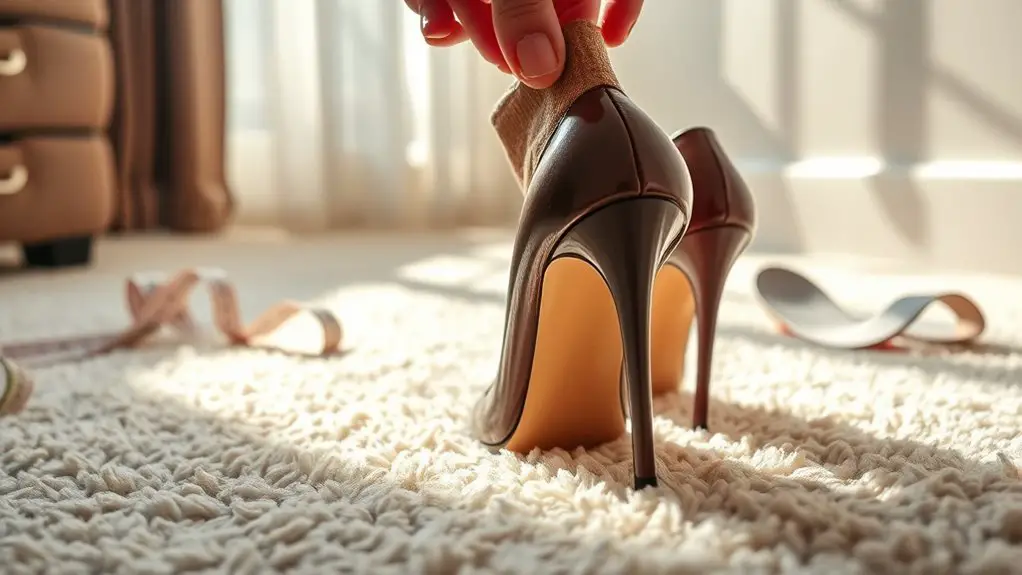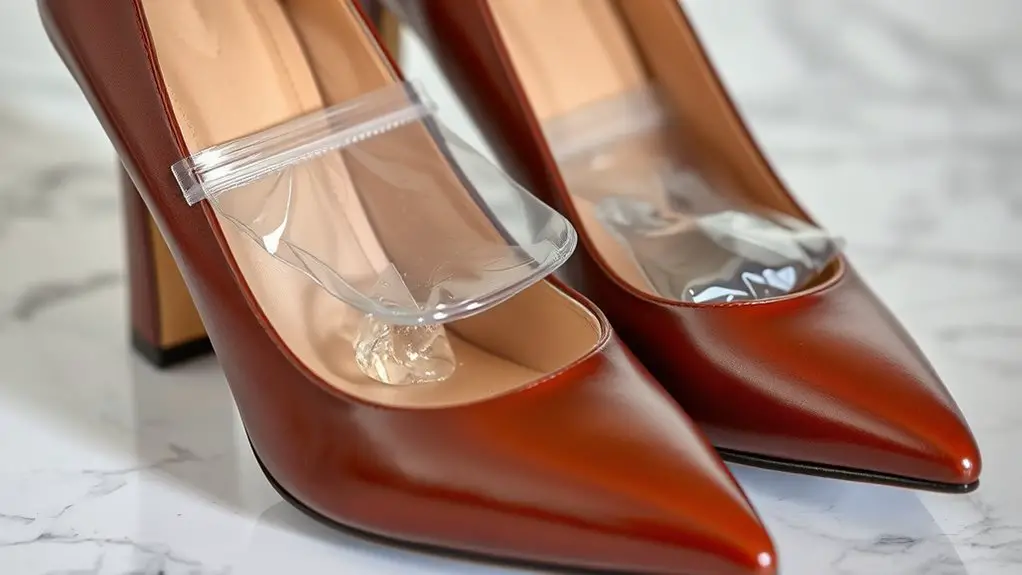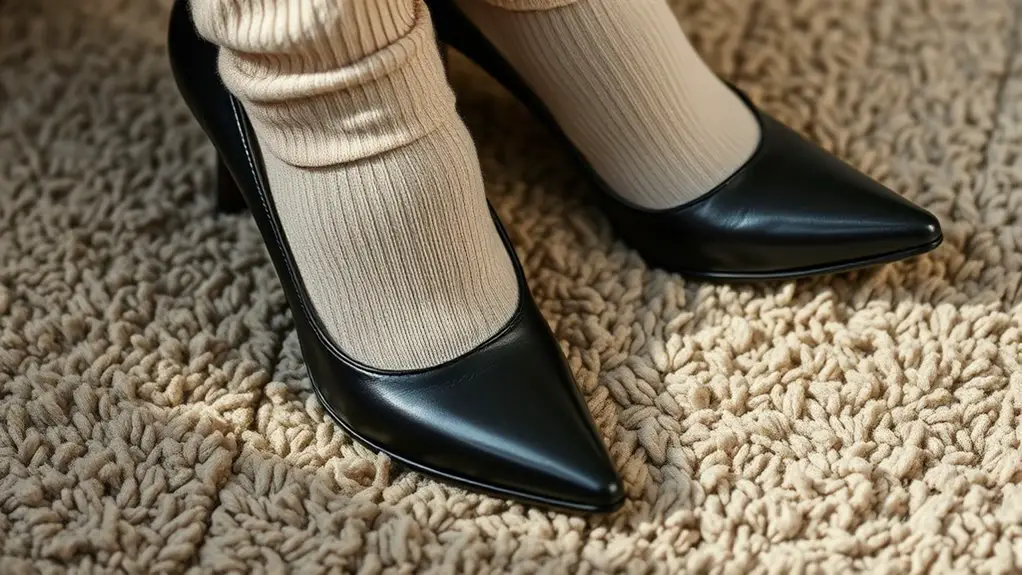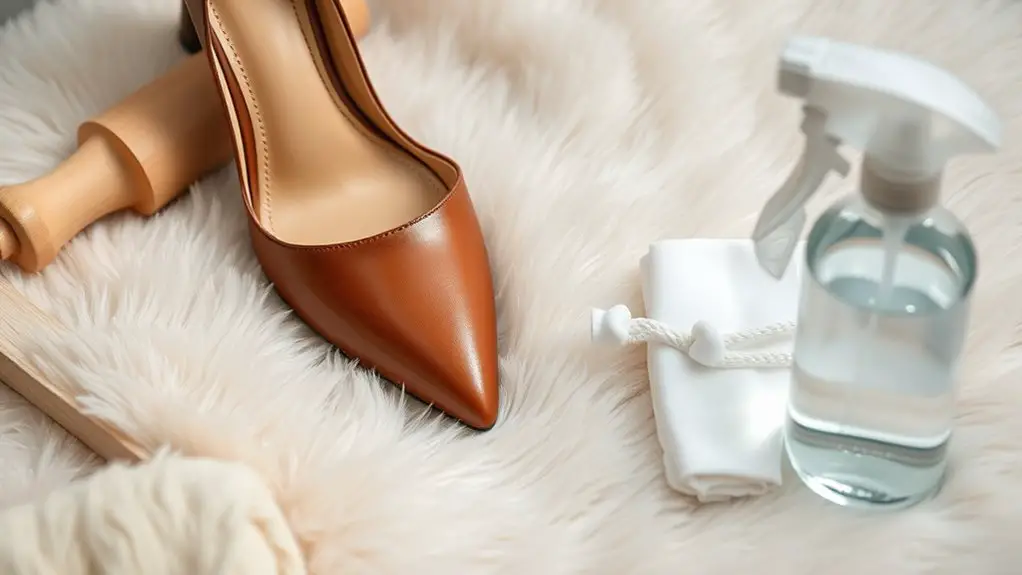To stretch tight heels without ruining them, use a shoe stretcher to apply even pressure, making certain it fits your shoe size. You can also try the freezing method by filling bags with water and freezing them inside your shoes. Applying heat with a hairdryer can soften the material, or simply wear thick socks to gradually stretch them. For more delicate shoes, consider professional services to guarantee they’re stretched safely and effectively. There’s more to discover!
Understanding the Importance of Proper Fit

When it comes to footwear, the right fit is essential for comfort and overall foot health. A proper fit isn’t just about size; it involves a thorough fit assessment that considers your foot anatomy, including arch type and width. Ill-fitting shoes can lead to numerous problems, from blisters to long-term issues like bunions and plantar fasciitis.
Start by measuring your feet regularly, as they can change over time. When trying on shoes, pay attention to how they hug your heel and toe box. There shouldn’t be excessive movement or pressure points. Remember that the heel should fit snugly without slipping. Taking the time to assess the fit correctly not only enhances comfort but also promotes healthy foot mechanics. Investing in footwear that accommodates your unique foot structure is vital for preventing discomfort and injury, so prioritize fit when shopping for your next pair.
Using a Shoe Stretcher for Optimal Results
When you’re ready to stretch your tight heels, choosing the right shoe stretcher is essential for effective results. You’ll want to select a model that fits your shoe size and shape, ensuring even pressure during the stretching process. Once you’ve got the right tool, employing proper stretching techniques will help you achieve the comfort and fit you desire.
Choosing the Right Stretcher
Choosing the right shoe stretcher can make all the difference in achieving ideal results for tight heels. With various stretcher types available, you’ll want to reflect on key factors to guarantee you select the best option for your needs. Here are some aspects to keep in mind:
- Material Quality: Look for durable materials that won’t damage your shoes.
- Adjustability: Opt for a stretcher that allows for precise alterations.
- Design: Choose one that fits well into your shoe’s shape and size.
- Ease of Use: A user-friendly design will save you time and effort.
- Price Point: Balance affordability with quality; sometimes, it pays to invest more for better results.
Proper Stretching Techniques
Having selected the right shoe stretcher, you’re now ready to employ proper stretching techniques to address those tight heels effectively. First, verify your stretcher fits the specific heel shapes of your shoes. Insert the stretcher into one shoe and turn the handle to gently expand it. Depending on the materials used in your shoes, you may want to apply stretching materials, like leather conditioner or spray, to soften the fabric prior to stretching. Leave the stretcher in for 24 hours for best results, and repeat if necessary. Always check the fit after each session; it’s vital not to over-stretch. This method guarantees your heels become comfortable without compromising their shape or integrity.
The Freezing Method: A Simple DIY Trick

One effective method to stretch tight heels involves using your freezer—yes, that’s right! The freezing method is a simple DIY trick that can help you achieve a more comfortable fit without damaging your shoes. Here’s how to do it:
A simple DIY trick to stretch tight heels involves using your freezer for a more comfortable fit.
- Fill two resealable plastic bags with water, ensuring they’re sealed tightly.
- Place the bags inside your heels, making sure they fit snugly.
- Put the shoes in the freezer overnight.
- Once frozen, remove the shoes and let them sit at room temperature for about 15 minutes.
- Take out the bags and try on your heels; they should feel noticeably looser.
This method works because as the water freezes, it expands, stretching the material of your heels gently. Always remember to monitor the process to avoid any cracks or damage. Happy stretching!
Applying Heat to Stretch Leather Heels
Applying heat is an effective way to stretch leather heels and achieve a more comfortable fit. To begin, gather a hairdryer or a heat gun, and set it to a low temperature. Focus on the areas of the heel that feel tight—hold the heat source about six inches away, moving it in circular motions to prevent scorching the leather. Aim for about 30 seconds of heat application per spot.
Once the leather feels warm and pliable, quickly put on the heels and walk around in them. This helps the material conform to your foot shape. If you need more stretch, repeat the process in small increments.
Wearing Thick Socks to Expand Tight Shoes

When you’re trying to stretch tight shoes, wearing thick socks can make a significant difference. Start by selecting the right pair—opt for socks made from a stretchy material to guarantee comfort. Gradually wear them with your shoes, increasing the time each day to help the footwear expand without causing discomfort.
Choose the Right Socks
If you’re struggling with tight shoes, wearing thick socks can be a simple yet effective solution to help stretch them out. Choosing the right socks is essential for this method to work effectively. Here are some options to take into account:
- Compression socks: These provide gentle pressure, helping to mold your shoes to your feet.
- Moisture-wicking socks: Keep your feet dry, reducing friction and discomfort during the stretching process.
- Padded socks: Extra cushioning can help fill in the gaps without causing too much tightness.
- Cotton blend socks: They offer comfort and breathability, ideal for extended wear.
- Wool socks: These naturally stretch and adapt to the shape of your shoe, providing warmth and comfort.
Try pairing your thick socks with your tight shoes for best results!
Gradual Wear Strategy
Building on the foundation of choosing the right socks, implementing a gradual wear strategy can markedly aid in expanding tight shoes. Start by wearing thick socks, as they create the necessary cushion for your feet while allowing for gentle expansion of the shoe material. Wear your shoes for short periods at first, making gradual adjustments to the duration as they start to loosen up. This method not only helps to stretch the shoes but also guarantees that the fit remains comfortable. If the shoes still feel tight after several wears, consider using a shoe stretcher overnight while still in the thick socks. This combination of techniques can effectively ease discomfort without compromising the shape or integrity of your heels.
Using Rubbing Alcohol to Soften Material
To effectively soften stiff materials like leather or synthetic fabrics, rubbing alcohol can be a surprisingly effective solution. This method is not only simple but also helps in material softening without compromising your heels. Here’s how to do it:
- Gather Supplies: You’ll need rubbing alcohol, a spray bottle, and a soft cloth.
- Prepare the Solution: Mix equal parts of rubbing alcohol and water in the spray bottle.
- Apply: Lightly spray the mixture onto the areas that feel tight, ensuring you don’t soak them.
- Flex and Wear: Gently flex the material while it’s damp, then wear the shoes for a short period to help mold them to your feet.
- Dry Properly: Allow the shoes to air dry completely before wearing them again.
Using rubbing alcohol can effectively soften material, making your tight heels more comfortable. Just remember to use it sparingly to avoid damage.
Professional Stretching Services: When to Consider
While using rubbing alcohol can be a handy DIY solution for softening tight materials, there are times when seeking professional help may be the better option. If your heels are particularly expensive or made from delicate materials, professional services can guarantee they’re stretched safely without damage. Skilled cobblers use specialized tools and techniques that provide precise stretch options tailored to your shoe’s specific needs.
Additionally, if you’ve tried DIY methods and still find discomfort, consulting a professional might save you time and frustration. For shoes that have stubborn tight spots or require significant adjustments, professionals can achieve results that are difficult to replicate at home. Remember, investing in professional stretching services can extend the life of your beloved heels and enhance your comfort. When in doubt, don’t hesitate to seek expert advice; it could make all the difference in your shoe-wearing experience.
Choosing the Right Insole for Comfort
When it comes to choosing the right insole for your heels, understanding the different types available is essential. You’ll want to evaluate materials that provide ideal support, as they can greatly impact your comfort and posture. Selecting the right insole not only helps alleviate tightness but also enhances your overall walking experience.
Types of Insoles Available
Choosing the right insole can greatly impact your comfort, especially if you’re dealing with tight heels. The right insole not only provides cushioning but also enhances arch support, helping alleviate pressure points. Here are five types of insoles to take into account:
- Cushioning Insoles: Offer extra padding for shock absorption.
- Arch Support Insoles: Help distribute weight evenly and reduce strain.
- Gel Insoles: Provide a soft, flexible feel for added comfort.
- Orthotic Insoles: Tailored for specific foot conditions, improving foot alignment.
- Memory Foam Insoles: Conform to your foot shape, offering personalized comfort.
Selecting the right type for your needs can make a significant difference, ensuring your heels remain comfortable and pain-free.
Material for Best Support
To guarantee ideal support and comfort for your heels, understanding the materials used in insoles is vital. Look for insoles made from high-quality foam or gel; these materials offer excellent cushioning and adaptability. For durability, consider thermoplastic polyurethane (TPU) insoles, which provide long-lasting support without compromising comfort.
When it comes to support types, arch support is essential for distributing weight evenly and alleviating pressure. If you need extra stability, choose insoles with a firm base, as they can help prevent foot fatigue during extended wear. Remember, the right insole can greatly enhance your heel’s fit and comfort, so invest wisely in materials that will withstand wear while giving you the support you need.
Regular Maintenance for Long-Lasting Comfort
While you may not think about it often, regular maintenance of your heels is essential for ensuring long-lasting comfort and preventing discomfort. By incorporating simple cleaning routines and regular inspections, you can extend the life of your favorite pairs. Here are some practical steps to keep in mind:
- Inspect for Damage: Regularly check for scuffs, loose parts, or worn-out soles.
- Clean Gently: Use a soft cloth and appropriate cleaner to maintain the material’s integrity.
- Store Properly: Keep your heels in a dust-free environment, preferably in their original boxes or dust bags.
- Condition Materials: For leather heels, use a conditioner to prevent cracking.
- Rotate Shoes: Alternate between pairs to prevent excessive wear on a single pair.
Tips for Breaking in New Heels Safely
After maintaining your heels for longevity, it’s time to focus on breaking in new pairs safely. Start by wearing your new heels for short periods at home. This helps your feet adjust gradually without causing discomfort. Consider using thick socks to create a snug fit while stretching the material gently. Remember, breaking habits of wearing overly comfortable shoes can make this shift challenging, so take it slow.
Incorporate heel care by investing in cushioned insoles that provide extra support. This will alleviate pressure and help you walk more comfortably. When you do wear them out, choose low-impact activities, like walking on flat surfaces, to minimize strain. Finally, give your feet breaks; switching shoes throughout the day can prevent excessive discomfort. With patience and proper care, you’ll find your new heels can become just as comfortable as your favorites.
Frequently Asked Questions
Can I Use These Methods on Synthetic Heels?
Yes, you can use stretching techniques on synthetic material, but proceed with caution. Test methods on a small area first. Heat or shoe stretchers can help, but avoid excessive force to prevent damage.
Will Stretching My Heels Affect Their Appearance?
When you’re stretching your heels, it’s essential to take into account the materials. Some stretching techniques might alter their appearance slightly, especially with delicate fabrics. Always test on a small area first to prevent any unwanted changes.
How Long Does the Stretching Process Take?
The stretching process can take anywhere from a few hours to several days, depending on the stretching techniques you use and the heel materials. Patience is key for effective results without compromising your shoes’ integrity.
Is It Safe to Stretch Heels Multiple Times?
Stretching heels multiple times can be safe, but you must use proper stretching techniques. Always prioritize footwear care; over-stretching might compromise your shoes. Gradual adjustments guarantee comfort without risking damage, so proceed carefully with each attempt.
What Should I Do if Stretching Doesn’T Work?
If stretching doesn’t work, consider alternative methods like using shoe stretchers or moisturizing techniques. If discomfort persists, seeking professional help from a cobbler or podiatrist can provide tailored solutions for your specific situation.



